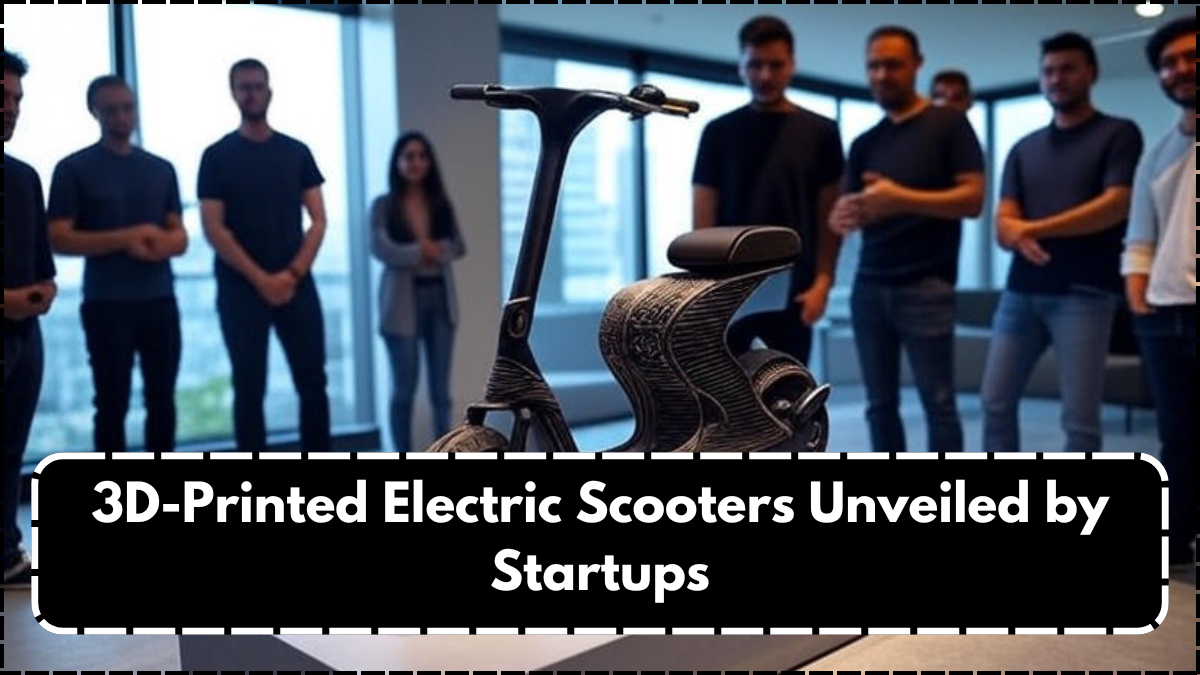The future of mobility is undergoing a massive transformation with the introduction of the 3D Printed Electric Scooter. Startups across the globe are showcasing their innovative edge by combining advanced 3D printing technology with eco-friendly electric mobility. This revolution not only reduces manufacturing costs but also allows greater customization, sustainability, and rapid prototyping. With Startup Innovation driving this trend, these scooters are set to redefine personal commuting in cities and beyond.

The Concept Behind a 3D Printed Electric Scooter
A 3D Printed Electric Scooter is manufactured using additive manufacturing techniques, where layers of material are built up to form the scooter’s frame and components. Unlike traditional mass-production methods, 3D printing provides agility and flexibility for startups to design, test, and deploy scooters faster.
Core features include:
- Lightweight, durable frames
- Reduced production waste
- Customizable designs tailored to consumer needs
- Integration of electric drivetrains for zero-emission transport
- Affordable pricing due to simplified manufacturing
This combination of sustainability and cost-effectiveness positions the scooters as a prime example of Startup Innovation in the mobility sector.
Why Startups Are Leading the Way
Large corporations often face high overheads and slower innovation cycles, but startups thrive in fast-paced, experimental environments. With the 3D Printed Electric Scooter, small companies can rapidly prototype new designs and launch them at a fraction of the traditional cost.
Startups bring key advantages such as:
- Agility in design and production
- Quick adaptation to consumer feedback
- Partnerships with tech labs and universities
- Focus on sustainability and eco-friendly solutions
- Competitive pricing to appeal to urban commuters
This agility makes Startup Innovation the backbone of the electric scooter industry’s evolution.
Comparing Traditional vs 3D Printed Electric Scooters
To understand the impact of 3D printing on this industry, let’s compare traditional scooters with the 3D Printed Electric Scooter:
| Feature | Traditional Electric Scooter | 3D Printed Electric Scooter |
|---|---|---|
| Manufacturing Process | Mass production, molds, casting | Additive manufacturing (3D printing) |
| Customization | Limited | High (custom designs possible) |
| Production Time | Longer (months) | Shorter (weeks/days for prototypes) |
| Cost Efficiency | Moderate | Higher due to reduced waste/materials |
| Environmental Impact | Moderate | Low (less waste, sustainable materials) |
| Innovation Flexibility | Slower | Rapid, startup-driven |
The table highlights why the 3D Printed Electric Scooter is gaining momentum as a smarter alternative for future mobility.
Benefits of 3D Printed Electric Scooters
The adoption of 3D Printed Electric Scooters offers multiple benefits to commuters, manufacturers, and the environment:
- Eco-Friendly: Uses sustainable materials and reduces production waste.
- Affordable: Lower manufacturing costs translate to budget-friendly pricing.
- Customizable: Scooters can be tailored to rider preferences, from design to ergonomics.
- Rapid Innovation: Startups can update models frequently without massive retooling.
- Urban-Friendly: Compact and lightweight, perfect for crowded cities.
Together, these benefits showcase why this represents a breakthrough in Startup Innovation and sustainable transport.
Challenges and Future Prospects
While promising, the 3D Printed Electric Scooter faces challenges before reaching mass adoption. Issues such as durability testing, large-scale production capacity, and regulatory approvals still need to be addressed. However, with Startup Innovation at the core, many of these obstacles are being tackled through collaborations with research labs, sustainable material suppliers, and government initiatives.
Future prospects include:
- Wider use of recyclable and biodegradable materials
- Integration with IoT and smart mobility apps
- Expansion into shared mobility fleets
- Export opportunities for startups in global markets
These advancements position the scooter as a long-term solution for clean and efficient commuting.
Conclusion
The 3D Printed Electric Scooter is a perfect example of how Startup Innovation can reshape industries. By leveraging cutting-edge 3D printing technology, startups are not only lowering production costs but also creating eco-friendly, customizable, and efficient commuting options. As urban populations grow and demand for sustainable transport increases, these scooters could soon become a common sight in cities worldwide.
FAQs
What is a 3D Printed Electric Scooter?
A 3D Printed Electric Scooter is a two-wheeler manufactured using 3D printing technology and powered by electricity, offering sustainable and customizable commuting solutions.
Why are startups focusing on 3D Printed Electric Scooters?
Startups use 3D printing for quick prototyping, cost efficiency, and greater flexibility, showcasing the strength of Startup Innovation.
Are 3D Printed Electric Scooters eco-friendly?
Yes, they reduce waste in production and use sustainable materials, making them more eco-friendly than traditional scooters.
Will 3D Printed Electric Scooters be affordable?
Yes, the simplified production process lowers costs, making them affordable for urban commuters.
Click here to learn more